-

人教版新目标初中英语七年级下册Where is your pen pal from教案
2.1Match the country with the language.Step II Reading3a? let the students read the letter fast and answer the questions.? Let the students ask more questions about the letter as possible as the can.Step III Writing3b.Step IV. Pairwork2cStep V Listening2a, 2bStep V. HomeworkExercises book(1) P3Exercises book (2) P3Period FourStep I . Dictate the words and sentences in Unit1.Step II. Self-checkStep III. Check the answers for Exercises book in the unit.Step IV. Home workRevise and preparation for unit 2.教学反思:通过本单元的学习,学生基本可以谈论人们的国籍,居住城市及其所说的语言,通过书信方式去介绍自己并寻找笔友。但在涉及到国外的一些城市时,学生对这方面的知识相对欠缺,能介绍的城市并不多,也反应出学生课前预习不充分,这跟学生学习条件也有关,大多数学生无法通过网络获取所需信息。因此,在以后的教学中要多指导学生通过计算机网络获取信息,拓宽知识面。
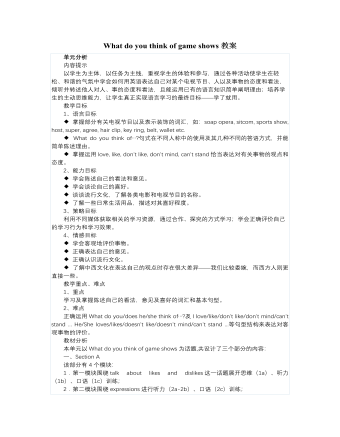
人教版新目标初中英语七年级下册What do you think of game shows教案
五、教学Section B-2c1. Pair work: What do you think of the belt/sunglasses/…? What does your father/mother/… think of your scarf/belt…?2. Group work(1). Teacher shows some different kinds of school uniforms (制服)and asks : “ What do you think of your school uniforms? If you have a chance to choose your school uniforms, what kind would you like to choose?”(2). Discuss in groups.(3).Get some Ss to report in class.说明:这一步旨在让学生运用已有的语言知识谈论对事物的看法和意见,并简单阐明理由,培养学生的主动思维能力和运用英语的能力。六、教学拓展调查电视节目的收视率任务:调查你周围的人对现在各种电视节目的反响。活动过程:1.教师布置任务,让学生调查周围的人(包括他的亲戚朋友和邻居)喜欢收看哪方面的电视节目。2.学生进行调查活动,运用本单元所学的句型What do you think of….? (Why?)What's your favorite game shows?What do you think of talk show?I doesn’t mind it.I like it.I love it.I can’t stand it.3.记录下排在前10位的TV Program,填写调查表,比较其收视率。

人教版新目标初中英语七年级下册Where did you go on vacation教案
句型: Where did you go on vacation? I went to summer camp.Did she go to Central Park?Yes,she did.No, she didn’t语法:一般过去时特殊疑问句、一般疑问句及肯、否定回答。课时安排4课时第一课时:Section A:la,1b,lc,2a,2b,2c 第二课时:Section A:3a,3b,4第三课时:Section B:1,2a,2b,2c第四课时:Section B:3a,3b,3c,4 and Self Check第一课时教学目标掌握描写假期生活的形容词。假期里自己所做事情的简单表达。谈论假期做的事情及当时情况。谈论假期时旅游的天气,旅游者以及食物等。教学过程一、导入播放一首英文歌曲:Let’s travel 说明:通过让学生听节奏欢快迪斯尼英语歌曲Let’s travel.引入本节课谈论的话题vacation and travel. 让歌曲使学生的思维活跃,增强课堂气氛,激发学生提高学习英语的兴趣。T:How is the trip ?Ss : It’s pretty good/ happy/exciting /relaxing/busy/dangerous/ fantastic说明:这个问题是为了操练形容词。建议让多个Ss作答。鼓励他们用不同的形容词。上述个别形容词本应在第二课时中出现,但可以在warming-up中第一次非正式出现。这些形容词也可在老师的评价语中适时出现,以加深学生对词汇的印象。
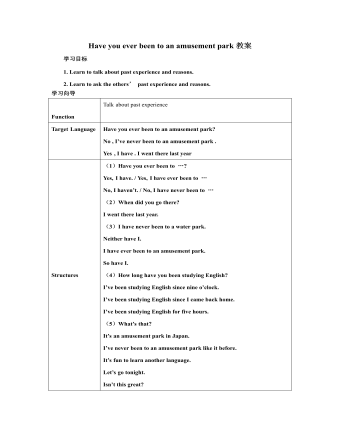
人教版新目标初中英语八年级下册Have you ever been to an amusement park教案
(1)Have you ever been to …? Yes, I have. / Yes, I have ever been to …No, I haven’t. / No, I have never been to …(2)When did you go there? I went there last year. (3)I have never been to a water park. Neither have I. I have ever been to an amusement park. So have I. (4)How long have you been studying English? I’ve been studying English since nine o’clock. I’ve been studying English since I came back home. I’ve been studying English for five hours. (5)What’s that? It’s an amusement park in Japan. I’ve never been to an amusement park like it before. It’s fun to learn another language. Let’s go tonight. Isn’t this great?space museum, amusement park, water park, South America, Peru, Holland, European culture, tour guide, flight attendant, musical instrument, more than, be from, get to, take lessons, neither, discover, graduate, change

人教版新目标初中英语八年级下册What should I do教案2篇
说明:在帮Li Lei提建议的同时,教育学生如何学好英语。第三课时教学目标1. 语言目标:a) 词汇: Original, in style, haircut, the same as.b) 语言结构:My friend wears the same clothes and has the same haircut as I do.2. 能力目标:大多数学生能够谈论自己喜欢哪种服装,提高查找信息的能力。3. 情感目标:学会如何与朋友相处,要有自己对时尚的看法。教学重点掌握一些重要词汇。教学难点学会谈论问题,并能提出书面建议。◆教学突破首先针对Erin的问题,提出个人的建议,模仿2c部分的对话展开双人交际Pair-work;听老师诵读3a部分的信件,并找出LEFT OUT的问题所在;学生完成3b部分的内容,给Left Out提出书面的建议;学以口头形式提出自己目前存在的某个问题,讲给大家听,让同学们给自己提出一个建议,并作笔录;学生两、三个人分成一组,随意性地进行口语交际,谈论P14的第4部分的某个问题,相互交换意见。

人教版新目标初中英语八年级下册It’s a nice day, isn’t it教案2篇
"Hello! Welcome to English class! Introduce yourself. Meet your new classmates." That's what the teacher says. What do you say? "Oh no!" It can be difficult talking to new people. But it can be fun, and you can make friends. How do you do it? Make small talk. Small talk is polite conversation. "Wang Nan is a great pingpang player, isn't she?" "I'd love to meet her, wouldn't you?" "It's been raining a lot, hasn't it?" Tag questions are a form of polite speech. To make small talk successfully, you should know how to make them. You should also know what topics to talk about. Try to learn this unit carefully. The next time you're in English class, you'll find out. Making small talk's easy, isn't it? (“你好!欢迎你!请做一下自我介绍。认识一下你的新同学。”通常在课上老师会这样说。你会说什么呢?“噢,不!”与陌生人谈话太困难了。但是这也很有意思,并且你还能交到朋友。你该怎么做呢?闲聊。闲聊指得是礼貌的对话。“王楠是一个很棒的乒乓球运动员,不是吗?”“我希望自己能认识她,你呢?“今年的雨水很多,不是吗?”反意疑问句是一种礼貌用语。为了使得谈话成功,你应该知道怎样去进行闲聊。你还应该知道与不同的人该谈论什么样的话题。认真的学习这个单元吧,下次在英语课上,你会发现与大家展开谈话是一件很容易的事情,不信我们来试试。)

人教版新目标初中英语八年级下册What were you doing when the UFO arrived教案2篇
(一).知识方面: 1.培养学生能运用过去进行时来描述、谈论过去某个时间正在发生的事情或动作的意识和能力,能就过去某个时间正在发生的动作做出正确的描述。 2.培养学生的想象力和角色扮演的合作能力。 3.培养学生讲述过去发生的事情经过的能力。能正确运用一般过去时来讲述故事。 (二).技能方面: 1.本单元的语言目标是Talk about past events and tell a story(谈论过去的时间和讲述一个故事),围绕这一目标,要涉及句型: What were you doing when the UFO arrived? ----I was sitting in the barber’s chair. The barber was cutting my hair. 因此必须学习standing、studying、cleaning、sleeping、cooking、making、eating、cutting、等表示地点的词,以便为上述句型提供语言材料。2.学习过去进行时的有关知识。Was/were+现在分词,是该时态的表达式。 3.在学习过程中,要区分The boy was walking down the street when the UFO landed.和While the boy was walking down the street, the UFO landed.这两种由when和while引导的状语从句的句型结构。注意它们的不同。

人教版新目标初中英语八年级下册Why don’t you get her a scarf教案
教师带领学生复习有关描述宠物的词汇,采用教师提问学生回答的方进行。如:T:What animals do you think would be good pets?What animals do you think would be bad pets?What do you think are good animals for a six-year-old child?然后学生进行 pairwork 练习。Task two: 师生互动,学习探究 1、播放3a部分的录音,引导学生一边听录音,一边跟读。2、通过听录音学生回答以下问题:Why do you think pot-bellied pigs are popular?What are the advantages and disadvantages of keeping such a pet?教师对学生的回答进行及时点评。3.学习范文,学习重点短语,为下步的模仿写作提供语言素材。T :1. )Have you ever kept a pig as a pet?Do you like pigs? St.:No.…Why don’t you like to keep a pig? St: No.They’re too dirty and lazy(Do you know in some foreign countries like Hollyland, Australia,pigs are the most popular pet.there’s a kind of pig.(图)it has an interesting name? it ‘s called a pot-bellied pig.) Now,let’s learn an article about this kind of interesting pet.2.)play the tapeSt.:Listen and repeat3.)show some Qs on computer(本子St.: read silently,then answerthe Qs(本子)4.)Ask ss. Close book and retell this passage.(what is a pot-bellied pig? Is it a good or bad pet? ) St.: retell it to each other“A pot –bellied pig is a popular pet now…”5.read the article together.St.:.practice reading
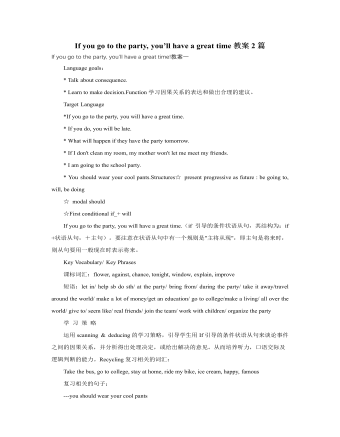
人教版新目标初中英语八年级下册If you go to the party, you’ll have a great time教案2篇
区分宾语从句、定于从句和状语从句宾语从句和状语从句,都叫做主从复合句。宾语从句主要是中考必考的,是初中阶段必掌握的从句,宾语从句主要是掌握三要素,所谓宾语从句,就是宾语在主从复合句当中充当宾语的一个句子,叫做宾语从句。主句的谓语动词是及物动词,后面如果是词或者是短语的话,是简单句,如果是句子的话,肯定是宾语从句。I know that he good at English.就是宾语从句,三要素,一要素是要注意连词,连词一共学了三类连词,一类连词是that口语当中可以省略,就像刚才说的那一句,I hear he is good at English.还有疑问代词、疑问副词,how where when,疑问代词、疑问副词。还有一类连词weather是否的意思,不是状语从句当中的如果,这一定要和如果区分开,这是是否。I don't know if he interested at English。宾语从句要注意if是连词。第二要素是语序,要用陈述举语序。比如说你家有几口人,我们都说How many people are there in you family?但是这是简单句,一旦说成宾语从句,你可以告诉我你家有几口人吗?Could you tell me how many people there are in you family ?

人教版新目标初中英语八年级下册How long have you been collecting shells教案2篇
Step Ⅱ Show the new words on the screen and teach the new words. Read the new words to students and ask them to repeat.Step Ⅲ 3aThis activity introduces new vocabulary and provides reading practice using the target language.In this activity first look at the four pictures.T: What can you see in the pictures?Ss: Four snow globes.T: Right. There are four snow globes in the pictures. And what are they?Ss: They are a monster, two polar bears, two penguins and a birthday cake.Write these words on the blackboard: snow globe; monster; polar bear; penguin and birthday cake. Read them to the class and ask students to repeat each one. Make sure students understand each word.Use a computer to show the E-mail message on the screen and read the message to students.Get students to read the e-mail on their own, and then draw lines connecting each snow globe and its description.Correct the answers.AnswersA line should connect each snow globe picture with the words that describe it in the letter.Step Ⅳ 3bThis activity provides writing practice using the target language.First review Activity 2a on Page 47.Then ask students to complete the message according to Activity 2a.Some partial sentences are given to students. Write about one person's collection.When students work, walk around the room checking the progress and offering help as needed.When they finish, ask some students to read their messages to the class.

人教版新目标初中英语八年级下册Would you mind turning down the music教案
Step 4. Group work (4)1. Ask a pair of students to read the dialogue. Say, This activity provides speaking, listening and writing practice using the target language.2. Ask students to complete the work in groups.3. Check the answers with the whole class. 4. Explain some of the language points. Step 5. Word review (Self check 1)1. Ask students to read the words and the phrases given. 2. Fill in the blanks with proper forms of these words to complete the sentences. 3. Check the answers with the whole class. Homework:Do activity 2 on page 57 after class. Period 6Teaching aims: 1. Teach vocabulary words and the useful expressions. 2. Enable the students to learn etiquette in different culture. 3. Help the students learn how to behave politely in public places and in daily life. Teaching procedures:Step 1. RevisionHelp students to review the function of making requests through a free talk. Then lead them to the topic of etiquette. Explain the meaning of etiquette. Or, ask students to look it up in the dictionary. Step 2. Pre-reading (Section 1)1. Ask students to read the picture and make a list with their partner about how many rules of etiquette can be seen being broken.

初中国旗下的讲话稿大全
国旗下讲话是对学生进行思想道德教育的重要载体。与其他德育形式相比,对于培养师生爱国情感、帮助学生树立远大理想、促进良好校风的形成,传播正能量,国旗下讲话有其不可替代的价值。本文是小编为大家整理的初中国旗下讲话稿,仅供参考。初中国旗下讲话稿篇一:尊敬的各位老师、亲爱的同学们:大家好!今天我演讲的题目是《安全常系心中》。你们知道生活中什么最重要吗?是安全。只有保证我们生命和生活的安全,一切才有意义。当同学们听到有关小学生意外伤害事故时,不知道你们想了些什么。我想,同学们至少会想到:这些教训无论发生在谁的身上都会给受害者人身造成伤害、甚至死亡;会给受害者家庭造成极大的损失;会给学校正常教学秩序造成混乱;会给社会造成不稳定影响。安全问题关系到我们每一位学生的切身利益,只有安全才能为我们保驾护航。在这里,我向全体同学发出倡议:1、校内课间不追逐打闹,上下楼梯慢步轻声,靠右行。2、放学按时离校,不在校园内逗留。3、不到小摊小贩购买食物,不吃不洁食物,喝水要讲究卫生,注意身体健康。4、保证用电安全,不乱动电源插座。

2024年农村移风易俗重点领域突出问题专项治理工作总结
(四)注重典型示范引领。以文明乡风助推乡村振兴,以榜样力量引领时代潮流,树立文明乡风需要发挥人的作用,通过榜样力量的引领,让文明乡风有前景、有根基。在“小手拉大手共建文明城”征文比赛活动中,XX区共有XX篇参赛作品获奖,其中一等奖XX篇,二等奖XX篇,三等奖XX篇,优秀奖XX篇。在全国最美家庭评选活动中,XX家庭被评为全国最美家庭。今年以来,XX区共向上级推荐市级新时代好少年XX名,省级文明校园XX个,文明单位XX个。学习榜样故事,感受榜样力量,激发奋进精神,激发干部群众争当模范,让好的标杆成为向上向善的力量。(五)强化宣传活动,营造浓厚氛围。充分利用各村(社区)宣传栏、横幅、标语、LED显示屏等载体广泛宣传,大力宣传有关婚丧改革的法律法规,宣传移风易俗的重大意义,引导广大群众从我做起,从小事做起,移风易俗,倡树新风,营造良好的工作氛围。

人教版新课标小学数学一年级下册两位数加一位数和整十数(不进位)说课稿2篇
(二)创设情境,探索新知。1、创设情境,激发兴趣。小白兔和小熊要坐公交车去公园,他们来到公交公司,先后看到公交公司有一边说一边课件出示课件,请同学们仔细观察,把你从图上看到的物品和读出的数据告诉老师和其他同学。你能根据这些信息提出不同的数学问题吗?再从同学们提出的众多问题中选择两个具有代表性的问题来列式和计算。课件出示主题图下列两个问题:指名说出两个问题的算式分别是什么,明确45 + 30和45 + 3是两位数加一位数和两位数加整十数的加法算式,引出课题——两位数加一位数和整十数(不进位)这一层次从学生熟悉的生活情境出发,选择学生熟悉的旅游,让学生自己发现、提出有关的数学问题,从而主动的解决问题。这里通过创造出生动的生活情境来提取例题,符合学生的年龄、认知特征,既激发了学生的学习兴趣,又使学生感受到数学与生活的密切联系,容易为学生所感知,所接受。
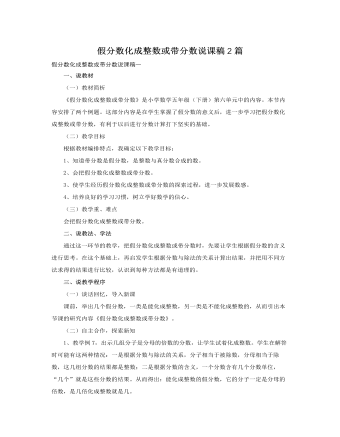
人教版新课标小学数学五年级下册假分数化成整数或带分数说课稿2篇
一、说教材(一)教材简析《假分数化成整数或带分数》是小学数学五年级(下册)第六单元中的内容。本节内容安排了两个例题。这部分内容是在学生掌握了假分数的意义后,进一步学习把假分数化成整数或带分数,有利于以后进行分数计算打下坚实的基础。(二)教学目标根据教材编排特点,我确定以下教学目标:1、知道带分数是假分数,是整数与真分数合成的数。2、会把假分数化成整数或带分数。3、使学生经历假分数化成整数或带分数的探索过程,进一步发展数感。4、培养良好的学习习惯,树立学好数学的信心。(三)教学重、难点会把假分数化成整数或带分数。二、说教法、学法通过这一环节的教学,把假分数化成整数或带分数时,先要让学生根据假分数的含义进行思考。在这个基础上,再启发学生根据分数与除法的关系计算出结果,并把用不同方法求得的结果进行比较,认识到每种方法都是有道理的。

人教版新课标小学数学一年级下册两位数减一位数和整十数(不退位)说课稿2篇
3、教学目标及教学重点难点根据课标的要求,介于教材的特点和学生实际,我确定本节课的教学目标是:(1)、知识与技能:让学生经历探索两位数减一位数和整十数(不退位)的计算方法的过程,掌握计算方法,能正确地口算。(2)、过程与方法:让学生经历自主探索、动手操作、合作交流等方式获得新知的过程,积累数学活动的经验,体会数学知识与日常生活的密切联系,增强应用意识。 (3)、情感态度与价值观:进一步培养学生学习数学的热情,以及积极思考、动手实践并与同学合作学习的态度。其中,掌握两位数减一位数和整十数(不退位)的口算方法是重点,理解算理,把握两位数减一位数与两位数减整十数在计算过程中的相同点与不同点是难点。

人教版新课标小学数学五年级下册一个数的因数和倍数的求法说课稿
在游戏中巩固知识,并体会区间套的数学思想,有利于培养学生的数感。做游戏时间不能过长,我只安排在4分钟内完成,让学生在学中乐和乐中学的兴趣。〈四〉全课总结今天这节课你们学了什么知识?有哪些收获?(让学生进行互说来结束本节课)五、说板书板书是体现课文内容脉落的载体。通过板书学生可以一目了然地弄请本节课你所授的内容知识的过程,让人永久深记,印象深刻。我的板书设计如下:一个数的因数和倍数的求法例1、18的因数有哪几个?18的因数有:1、2、3、6、9、18一个数的因数的个数是有限的,其中最小是1,最大的因数是它本身。方法:①哪两个自然数积等于18,则哪两个自然数就是这个数的因数。②哪个数能整除18,则哪个数就是这个数的因数。例2、2的倍数有哪些?一个数的倍数的个数是无限的,其中最小的倍数是它本身,没有最大的倍数。方法:用2与所有的自然数相乘,积就是它的倍数。

人教版新课标小学数学四年级下册把高级单位改写成低级单位:名数的改写说课稿
一、教材分析:《名数的改写》是四年级下册小数的意义和性质的内容。该内容是在学生已经学习了利用小数点位置移动引起小数的大小变化规律的基础上进行教学的。本信息窗呈现的是一只天鹅从出生到长大体重变化的情况。图中用文字标出了具体的变化数据。主要通过引导学生解答天鹅体重变化的问题,让学生体会到单位不相同,必须改写成相同的单位,展开对名数改写知识的学习。二、教学目标根据上述对教材的分析,考虑到学生已有的认知结构和心理特征,我确立了本课的教学目标为:知识与技能方面:会利用移动小数点的位置来进行名数改写。理解知识间联系,提高学生运用所学知识解决问题的能力。过程与方法方面:利用小数点位置移动引起小数大小变化的规律和名数改写的基本方法,引导学生进行知识迁移,从而掌握利用小数点的位置移动进行名数改写的方法。
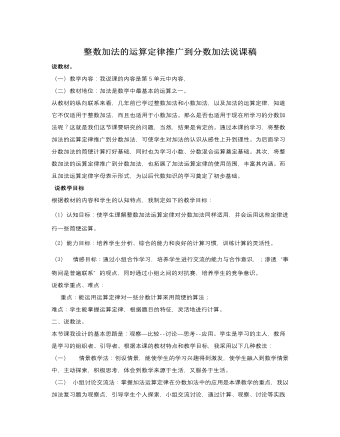
人教版新课标小学数学五年级下册整数加法的运算定律推广到分数加法说课稿
(一)教学内容:我说课的内容是第5单元中内容,(二)教材地位:加法是数学中最基本的运算之一。从教材的纵向联系来看,几年前已学过整数加法和小数加法,以及加法的运算定律,知道它不仅适用于整数加法,而且也适用于小数加法。那么是否也适用于现在所学习的分数加法呢?这就是我们这节课要研究的问题,当然,结果是肯定的。通过本课的学习,将整数加法的运算定律推广到分数加法,可使学生对加法的认识从感性上升到理性。为后面学习分数加法的简便计算打好基础,同时也为学习小数、分数混合运算奠定基础。其次,将整数加法的运算定律推广到分数加法,也拓展了加法运算定律的使用范围,丰富其内涵。而且加法运算定律字母表示形式,为以后代数知识的学习奠定了初步基础。

人教版新课标小学数学二年级下册两位数加两位数(口算)说课稿2篇
(四)、课堂总结、体验成功引导学生对所学知识、学习方法、学习结果、情感等进行全面总结,让学生体验学习的成功感,同时,进一步系统、完善知识结构。总之,本课的教学设计力求体现“以学生为本”的教学理念,具体体现在以下几个方面:(一)、创设生动的情景,激发探索的乐趣,让学生感受数学与生活的联系。课的引入以一幅学生经常接触的,喜闻乐见的购买玩具这一题材为切入点。在练习设计中,改变枯燥抽象的数字计算练习,选取了一组寓有童趣的素材。它们以丰富多彩的呈现方式深深地吸引着学生,使他们认识到现实生活中蕴含着大量的数学信息,使学生感到有趣、有挑战性,激发他们好奇,好胜的心理,从而诱发他们去主动寻求解决问题的策略,同时体验到数学与生活的联系。
